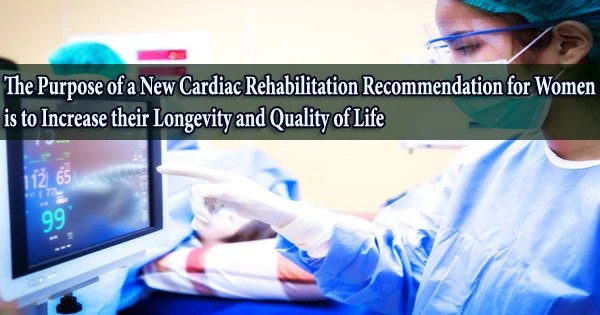Women who have cardiovascular disease (CVD) typically have worse results and are less likely than males to participate in preventative and rehabilitation programs.
A clinical practice guideline was created by a panel of experts assembled by the International Council of Cardiovascular Prevention and Rehabilitation (ICCPR) and supported by 24 clinical societies worldwide in order to offer direction to the cardiac rehabilitation community on how to deliver more successful women-focused programming. The recommendation may be found in the Canadian Journal of Cardiology, an Elsevier publication.
“It has long been established that women are significantly less likely to access and complete cardiac rehab (CR), and that their outcomes are often poorer, despite greater need than men,” explained lead author Sherry L. Grace, PhD, CRFC, Faculty of Health, York University; and KITE-Toronto Rehabilitation Institute and Peter Munk Cardiac Centre, University Health Network, University of Toronto, Toronto, ON, Canada.
“Accordingly, ‘women-focused’ models of CR have been developed to better engage women and optimize their outcomes. There is now sufficient evidence on women-focused CR to make recommendations to the CR community.”
In order to improve the results for women, this ICCPR clinical practice guideline offers advice to the CR community on how to establish programs for women with CVD, including stroke and peripheral arterial disease (PAD), and how to promote their engagement (i.e., death, hospitalization, function, psychosocial wellbeing, and quality of life). The recommendations prioritize cost, resource implications, practicability, and patient preferences.
Through an examination of the scientific literature and programs providing women-focused CR all around the world as identified by the ICCPR’s Global Audit, the ICCPR was able to identify women-focused CR researchers.
A writing and consensus panel was created by individuals and programs that gave their agreement. Its members included interdisciplinary healthcare providers from different geographic regions, a policymaker, and patient partners. The recommendations were written and examined by this committee.
Before being finalized, the proposal underwent external assessment by CR societies around the world and was made available online for public feedback. Canada, which is regarded as a leader in women-focused CR, provided one-third of the research found in the study that served as the foundation for the guideline.
It has long been established that women are significantly less likely to access and complete cardiac rehab (CR), and that their outcomes are often poorer, despite greater need than men. Accordingly, ‘women-focused’ models of CR have been developed to better engage women and optimize their outcomes. There is now sufficient evidence on women-focused CR to make recommendations to the CR community.
Sherry L. Grace
The recommendation list includes 15 suggestions for referral (automatic plus encouragement), setting (e.g., delivery mode selection, surroundings, customizing, and staff training), and delivery (e.g., session timing options, preferred form of exercise, psychosocial assessment and care, and education on women and heart disease). When implemented, these suggestions and the tools that go along with them might theoretically support some level of women-focused CR as a component of any program.
Key recommendations are:
- In order to remove gender-related barriers, women should be consistently referred to CR and encouraged to attend before being released from the hospital.
- A woman’s contextual and complete clinical history, including any mental health and psychosocial issues, menopausal status, frailty, cancer history, and concerns about urinary incontinence, falls risk/osteoporosis, as well as autoimmune conditions, should be taken into consideration when creating her customized rehab plan.
- The majority of the definitional components of women-focused CR should be included in any program’s women-focused programming. This might involve providing, for instance, certain women-only virtual education or exercise classes or peer support programs where resources are few.
- Women should have the option of engaging in programs that are center-based (clinical or community-based) or home-based, administered in a setting that is welcoming to them, and designed with their needs and preferences in mind.
- Strong psychosocial elements, a variety of exercise modalities, and specialized teaching on women and CVD should all be included in programs. Women’s psychosocial needs should be identified and met in a research-based way (e.g., social support, relationship health, depression, anxiety, stress, socioeconomic issues, informal caregiving activities).
“For the first time, there are a consensus definition and recommendations for women-focused CR, so it is hoped now that many programs will incorporate these elements into their programs,” said Prof. Grace. “If implemented, more women may engage in CR, and as a result have significantly greater quality and quantity of life.”
“The ICCPR acknowledges that across the globe women have experienced worse outcomes from CVD and worse uptake to prevention and rehabilitation programs,” commented Robyn Gallagher, MN, PhD, Chair, ICCPR, and Sydney Nursing School, Faculty of Medicine and Health, The University of Sydney, Sydney, Australia.
“The Women-Focused Cardiovascular Prevention and Rehabilitation Clinical Practice Guideline provides recommendations that will help clinicians and health service designers to develop and deliver programs that address this inequity for women, regardless of resource contexts.”
With almost 6,400 cases per 100,000 people, CVD is the leading cause of death for women worldwide. While the burden of CVD has declined globally since 1990, it has increased in many African, Asian, and Western Pacific nations, and the prevalence fall has stalled globally since 2010.
In comparison to men, fewer women with CVD undergo diagnostic tests, secondary preventive medications, and revascularization treatments.





